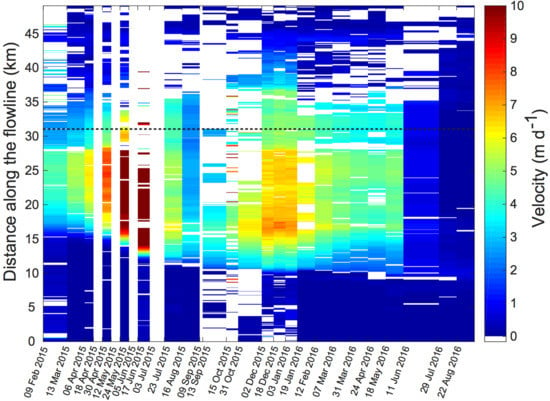The 2015 Surge of Hispar Glacier in the Karakoram
Abstract
:1. Introduction
2. Study Region
3. Data Sets and Image Processing Methods
3.1. Data Sets
3.2. Methods
4. Results
4.1. Historic Development of Hispar Glacier from Landsat Data
4.2. The 2015/16 Surge from Optical Images
4.3. Flow Velocities before, during and after the Surge
4.4. Accuracy of the Derived Flow Velocities
5. Discussion
5.1. Interpretation of the Observations
5.2. Is the Surge Unprecedented?
5.3. Interpretation of Observations
6. Conclusions
Supplementary Materials
Acknowledgments
Author Contributions
Conflicts of Interest
Abbreviations
| a.s.l. | above sea level |
| csv | comma separated values |
| DEM | Digital Elevation Model |
| ETM+ | Enhanced Thematic Mapper Plus |
| HG | Hispar Glacier |
| RADAR | RAdio Detection And Ranging |
| RGB | Red, Green, and Blue |
| MSS | Multispectral Scanner |
| SAR | Synthetic Aperture Radar |
| SLC | Scan-line-corrector |
| SRTM | Shuttle Radar Topography Mission |
| TM | Thematic Mapper |
| USGS | United States Geological Survey |
Appendix A

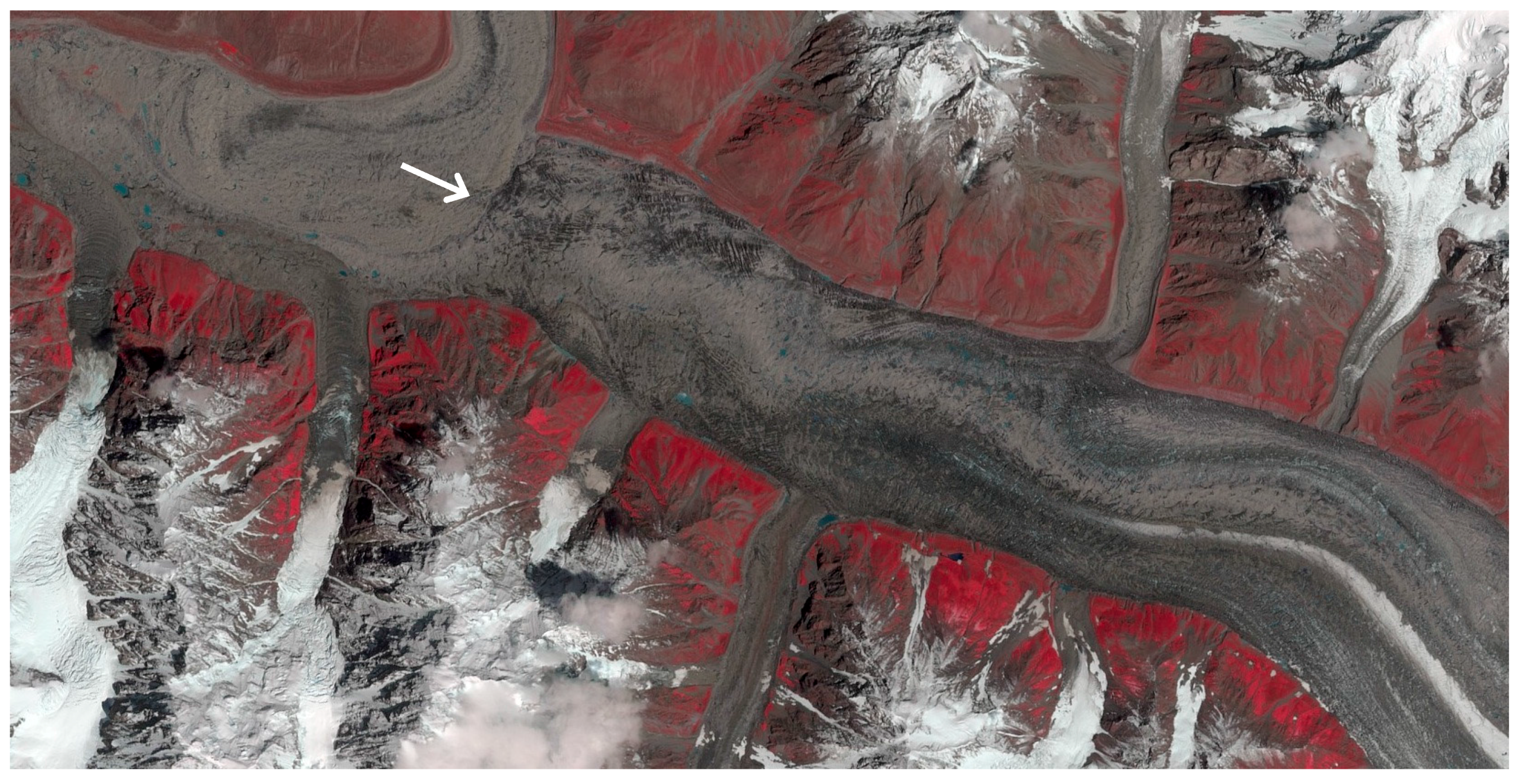
Appendix B
| ID | Sensor | Date | DoY | ID | Sensor | Date | DoY |
|---|---|---|---|---|---|---|---|
| 1 | L8 OLI | 9 October 2013 | 282 | 8 | L7 ETM+ | 20 August 2015 | 232 |
| 2 | L8 OLI | 25 August 2014 | 237 | 9 | L8 OLI | 13 September 2015 | 256 |
| 3 | L8 OLI | 26 September 2014 | 269 | 10 | L8 OLI | 15 October 2015 | 288 |
| 4 | L8 OLI | 16 January 2015 | 16 | 11 | L8 OLI | 10 May 2016 | 131 |
| 5 | L8 OLI | 21 March 2015 | 80 | 12 | L8 OLI | 26 May 2016 | 147 |
| 6 | L8 OLI | 22 April 2015 | 112 | 13 | MSS | 2 August 1977 | 214 |
| 7 | L8 OLI | 9 June 2015 | 160 | 14 | TM | 7 August 1990 | 219 |
| Date 1 | Date 2 | ∆t | Sensor | Figure | Date 1 | Date 2 | ∆t | Sensor | Figure |
|---|---|---|---|---|---|---|---|---|---|
| 5 July 2013 | 21 July 2013 | 16 | L8 OLI | 3a | 29 January 2014 | 3 April 2014 | 64 | L8 OLI | |
| 21 July 2013 | 7 September 2013 | 48 | L8 OLI | 3b | 3 April 2014 | 6 June 2014 | 64 | L8 OLI | |
| 7 September 2013 | 9 October 2013 | 32 | L8 OLI | 6 June 2014 | 8 July 2014 | 32 | L8 OLI | ||
| 9 October 2013 | 25 October 2013 | 16 | L8 OLI | 8 July 2014 | 24 July 2014 | 16 | L8 OLI | 3c | |
| 25 October 2013 | 10 November 2013 | 16 | L8 OLI | 24 July 2014 | 25 August 2014 | 32 | L8 OLI | 3d | |
| 10 November 2013 | 26 November 2013 | 16 | L8 OLI | 25 August 2014 | 5 November 2014 | 16 | L8 OLI | 3e | |
| 26 November 2013 | 12 December 2013 | 16 | L8 OLI | 5 November 2014 | 8 January 2015 | 64 | L7 ETM+ | 3f/g | |
| 12 December 2013 | 29 January 2014 | 48 | L8 OLI | 8 January 2015 | 9 February 2015 | 32 | L7 ETM+ | 3h |
| Date 1 | Date 2 | ∆t | Sensor | Date 1 | Date 2 | ∆t | Sensor |
|---|---|---|---|---|---|---|---|
| 13 March 15 | 6 April 15 | 24 | Sentinel-1 | 18 December 15 | 3 January 16 | 16 | L8 OLI |
| 6 April 15 | 18 April 15 | 12 | Sentinel-1 | 3 January 16 | 19 January 16 | 16 | L8 OLI |
| 30 April 15 | 12 May 15 | 12 | Sentinel-1 | 19 January 16 | 12 February 16 | 24 | Sentinel-1 |
| 24 May 15 | 5 June 15 | 12 | Sentinel-1 | 12 February 16 | 7 March 16 | 24 | Sentinel-1 |
| 17 June 15 | 3 July 15 | 16 | L7 ETM+ | 7 March 16 | 31 March 16 | 24 | Sentinel-1 |
| 23 July 15 | 16 August 15 | 24 | Sentinel-1 | 31 March.16 | 24 April 16 | 24 | Sentinel-1 |
| 16 August 15 | 9 September 15 | 24 | Sentinel-1 | 24 April 16 | 18 May 16 | 24 | Sentinel-1 |
| 13 September 15 | 15 October 15 | 32 | L8 OLI | 18 May 16 | 11 June 16 | 24 | Sentinel-1 |
| 15 October 15 | 31 October 15 | 16 | L8 OLI | 11 June 16 | 29 July 16 | 48 | Sentinel-1 |
| 31 October 15 | 2 December 15 | 32 | L8 OLI | 29 July 16 | 22 August 16 | 24 | Sentinel-1 |
| 2 December 15 | 18 December 15 | 16 | L8 OLI | 22 August 16 | 15 September 16 | 24 | Sentinel-1 |
References
- Copland, L.; Sylvestre, T.; Bishop, M.P.; Shroder, J.F.; Seong, Y.B.; Owen, L.A.; Bush, A.; Kamp, U. Expanded and recently increased glacier surging in the Karakoram. Arct. Antarct. Alp. Res. 2011, 43, 503–516. [Google Scholar] [CrossRef]
- Hewitt, K. Tributary glacier surges: An exceptional concentration at Panmah Glacier, Karakoram Himalaya. J. Glaciol. 2007, 53, 181–188. [Google Scholar] [CrossRef]
- Rankl, M.; Kienholz, C.; Braun, M. Glacier changes in the Karakoram region mapped by multimission satellite imagery. Cryosphere 2014, 8, 977–989. [Google Scholar] [CrossRef] [Green Version]
- Paul, F. Revealing glacier flow and surge dynamics from animated satellite image sequences: Examples from the Karakoram. Cryosphere 2015, 9, 2201–2214. [Google Scholar] [CrossRef] [Green Version]
- Quincey, D.J.; Glasser, N.F.; Cook, S.J.; Luckman, A. Heterogeneity in Karakoram glacier surges. J. Geophys. Res. Earth Surf. 2015, 120. [Google Scholar] [CrossRef]
- Rankl, M.; Braun, M. Glacier elevation and mass changes over the central Karakoram region estimated from TanDEM-X and SRTM/X-SAR digital elevation models. Ann. Glaciol. 2016, 51, 273–281. [Google Scholar] [CrossRef]
- Jiskoot, H. Glacier surging. In Encyclopedia of Snow, Ice and Glaciers; Singh, V.P., Singh, P., Haritashya, U.K., Eds.; Springer: Heidelberg, Germany, 2011; pp. 415–428. [Google Scholar]
- Kotlyakov, V.M.; Osipova, G.B.; Tsvetkov, D.G.; Jacka, J. Monitoring surging glaciers of the Pamirs, Central Asia, from space. Ann. Glaciol. 2008, 48, 125–134. [Google Scholar] [CrossRef]
- Grant, K.L.; Stokes, C.R.; Evans, I.S. Identification and characteristics of surge-type glaciers on Novaya Zemlya, Russian Arctic. J. Glaciol. 2009, 55, 960–972. [Google Scholar] [CrossRef] [Green Version]
- Herreid, S.; Truffer, M. Automated detection of unstable glacier flow and a spectrum of speedup behavior in the Alaska Range. J. Geophys. Res. Earth Surf. 2016, 121, 64–81. [Google Scholar] [CrossRef]
- Copland, L.; Pope, S.; Bishop, M.P.; Shroder, J.F.; Clendon, P.; Bush, A.; Kamp, U.; Seong, Y.B.; Owen, L.A. Glacier velocities across the central Karakoram. Ann. Glaciol. 2009, 50, 41–49. [Google Scholar] [CrossRef]
- Quincey, D.J.; Braun, M.; Glasser, N.F.; Bishop, M.P.; Hewitt, K.; Luckman, A. Karakoram glacier surge dynamics. Geophys. Res. Lett. 2011, 38. [Google Scholar] [CrossRef]
- Bhambri, R.; Bolch, T.; Kawishwar, P.; Dobhal, D.P.; Srivastava, D.; Pratap, B. Heterogeneity in glacier response in the upper Shyok valley, northeast Karakoram. Cryosphere 2013, 7, 1385–1398. [Google Scholar] [CrossRef] [Green Version]
- Gardelle, J.; Berthier, E.; Arnaud, Y.; Kääb, A. Region-wide glacier mass balances over the Pamir-Karakoram-Himalaya during 1999–2011. Cryosphere 2013, 7, 1263–1286. [Google Scholar] [CrossRef] [Green Version]
- Eisen, O.; Harrison, W.D.; Raymond, C.F.; Echelmeyer, K.A.; Bender, G.A.; Gorda, J.L.D. Variegated Glacier, Alaska, USA: A century of surges. J. Glaciol. 2005, 51, 399–406. [Google Scholar] [CrossRef]
- Sevestre, H.; Benn, D.I. Climatic and geometric controls on the global distribution of surge-type glaciers: Implications for a unifying model of surging. J. Glaciol. 2015, 61, 646–659. [Google Scholar] [CrossRef] [Green Version]
- Quincey, D.J.; Luckman, A. Brief Communication: On the magnitude and frequency of Khurdopin glacier surge events. Cryosphere 2014, 8, 571–574. [Google Scholar] [CrossRef] [Green Version]
- Fowler, H.J.; Archer, D.R. Conflicting signals of climatic change in the Upper Indus Basin. J. Clim. 2006, 19, 4276–4293. [Google Scholar] [CrossRef]
- Bocchiola, D.; Diolaiuti, G. Recent (1980–2009) evidence of climate change in the upper Karakoram, Pakistan. Theor. Appl. Climatol. 2013, 113, 611–641. [Google Scholar] [CrossRef]
- Bookhagen, B.; Burbank, D.W. Toward a complete Himalayan hydrological budget: Spatiotemporal distribution of snowmelt and rainfall and their impact on river discharge. J. Geophys. Res. 2010, 115. [Google Scholar] [CrossRef]
- Dahri, Z.H.; Ludwig, F.; Moors, E.; Ahmad, B.; Khan, A.; Kabat, P. An appraisal of precipitation distribution in the high-altitude catchments of the Indus basin. Sci. Total Environ. 2016, 548–549, 289–306. [Google Scholar] [CrossRef]
- Wake, C.P. Glaciochemical investigations as a tool to determine the spatial variation of snow accumulation in the Central Karakoram, Northern Pakistan. Ann. Glaciol. 1989, 13, 279–284. [Google Scholar] [CrossRef]
- Hewitt, K. Glacier Change, Concentration, and Elevation Effects in the Karakoram Himalaya, Upper Indus Basin. Mt. Res. Dev. 2011, 31, 188–200. [Google Scholar] [CrossRef]
- Kääb, A.; Treichler, D.; Nuth, C.; Berthier, E. Brief Communication: Contending estimates of 2003–2008 glacier mass balance over the Pamir-Karakoram-Himalaya. Cryosphere 2015, 9, 557–564. [Google Scholar] [CrossRef]
- Pfeffer, W.T.; Arendt, A.A.; Bliss, A.; Bolch, T.; Cogley, J.G.; Gardner, A.S.; Hagen, J.O.; Hock, R.; Kaser, G.; Kienholz, C.; et al. The Randolph Glacier Inventory: A globally complete inventory of glaciers. J. Glaciol. 2014, 60, 537–552. [Google Scholar] [CrossRef] [Green Version]
- Kääb, A.; Vollmer, M. Surface geometry, thickness changes and flow fields on creeping mountain permafrost: Automatic extraction by digital image analysis. Permafr. Periglac. Proc. 2000, 11, 315–326. [Google Scholar] [CrossRef]
- Heid, T.; Kääb, A. Evaluation of different image matching methods for deriving glacier surface displacements globally from optical satellite imagery. Remote Sens. Environ. 2012, 118, 339–355. [Google Scholar] [CrossRef]
- Strozzi, T.; Murray, T.; Wegmüller, U.; Werner, C. Glacier Motion Estimation Using SAR Offset-Tracking Procedures. IEEE Trans. Geosci. Remote Sens. 2002, 40, 2384–2391. [Google Scholar] [CrossRef]
- Wake, C.; Searle, M. Rapid advance of Pumarikish Glacier, Hispar Glacier Basin, Karakoram Himalaya. J. Glaciol. 1993, 39, 204–206. [Google Scholar] [CrossRef]
- Strozzi, T.; Kääb, A.; Schellenberger, T. Frontal destabilization of Stonebreen, Edgeøya, Svalbard. Cryosphere 2017, 11, 553–566. [Google Scholar] [CrossRef]
- Frezzotti, M.; Capra, A.; Vittuari, L. Comparison between glacier velocities inferred from GPS and sequential satellite images. Ann. Glaciol. 1998, 27, 54–60. [Google Scholar]
- Dehecq, A.; Gourmelen, N.; Trouve, E. Deriving large-scale glacier velocities from a complete satellite archive: Application to the Pamir-Karakoram-Himalaya. Remote Sens. Environ. 2015, 162, 55–56. [Google Scholar] [CrossRef]
- Wilson, R.; Mernild, S.H.; Malmros, J.K.; Bravo, C.; Carrión, D. Surface velocity fluctuations for Glaciar Universidad, central Chile, between 1967 and 2015. J. Glaciol. 2016, 62, 847–860. [Google Scholar] [CrossRef] [Green Version]
- Kääb, A.; Winsvold, S.H.; Altena, B.; Nuth, C.; Nagler, T.; Wuite, J. Glacier Remote Sensing Using Sentinel-2. Part I: Radiometric and Geometric Performance, and Application to Ice Velocity. Remote Sens. 2016, 8, 598. [Google Scholar] [CrossRef]
- Raymond, C.F. How do glaciers surge? A review. J. Geophys. Res. 1987, 92, 9121–9134. [Google Scholar] [CrossRef]
- Dunse, T.; Schellenberger, T.; Hagen, J.O.; Kääb, A.; Schuler, T.V.; Reijmer, C.H. Glacier-surge mechanisms promoted by a hydro-thermodynamic feedback to summer melt. Cryosphere 2015, 9, 197–215. [Google Scholar] [CrossRef]
- Round, V.; Leinss, S.; Huss, M.; Haemmig, C.; Hajnsek, I. Surge dynamics and lake outbursts of Kyagar Glacier, Karakoram. Cryosphere 2017, 11, 723–739. [Google Scholar] [CrossRef]
- Yasuda, T.; Furuya, M. Dynamics of surge-type glaciers in West Kunlun Shan, Northwestern Tibet. J. Geophys. Res. Earth Surf. 2015, 120, 2393–2405. [Google Scholar] [CrossRef]
- Bolch, T.; Pieczonka, T.; Mukherjee, K.; Shea, J. Brief communication: Glaciers in the Hunza catchment (Karakoram) have been nearly in balance since the 1970s. Cryosphere 2017, 11, 531–539. [Google Scholar] [CrossRef]
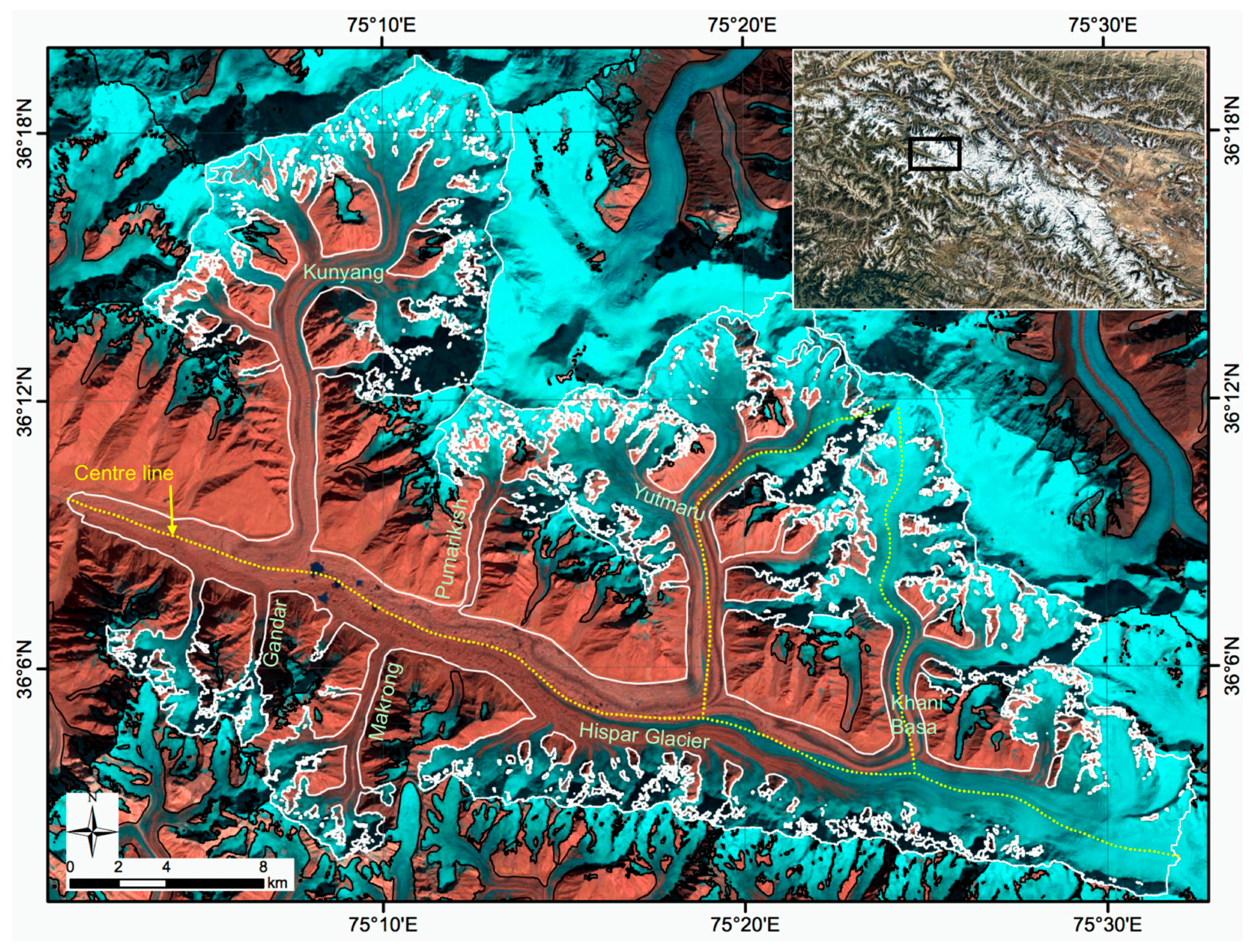
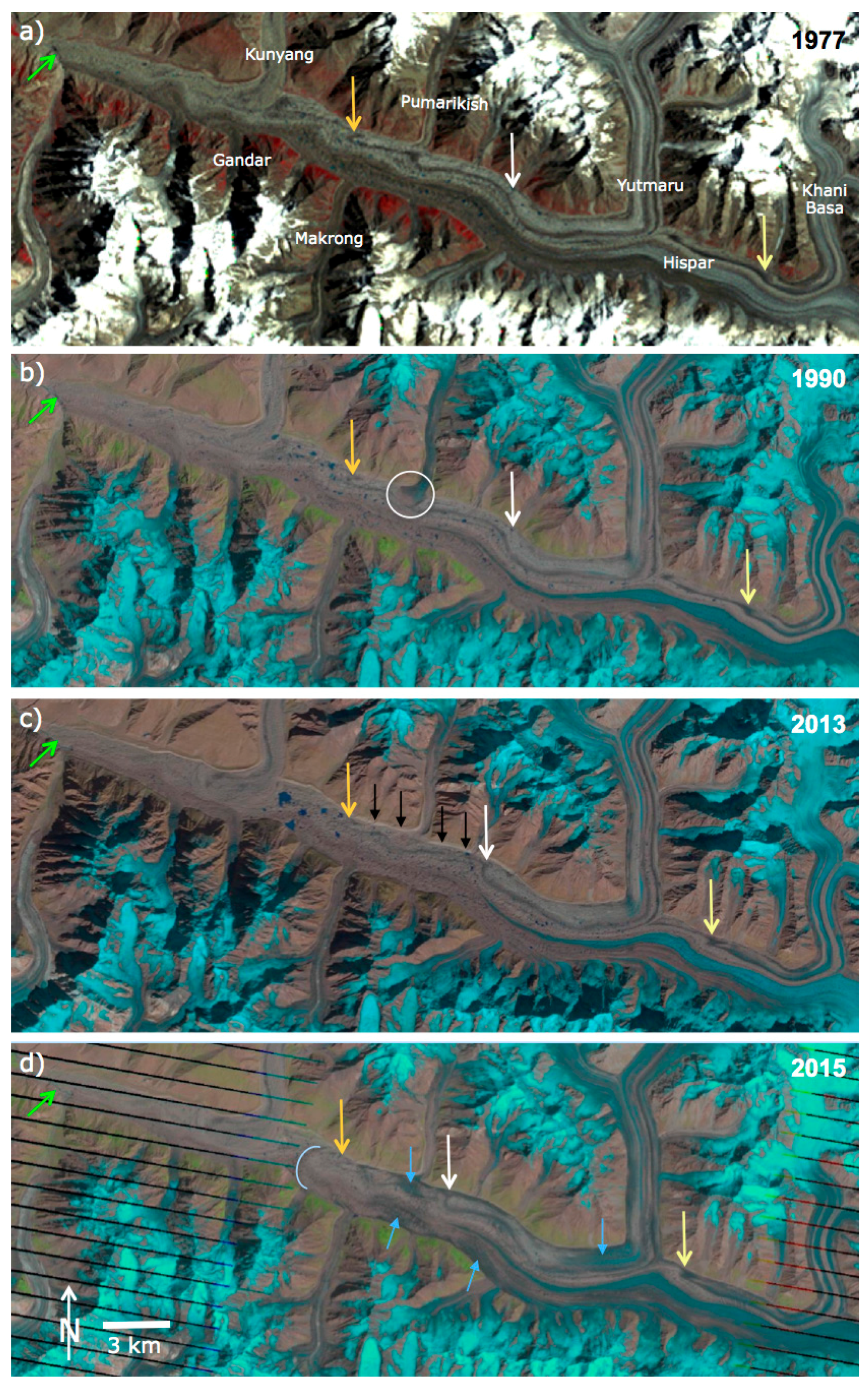

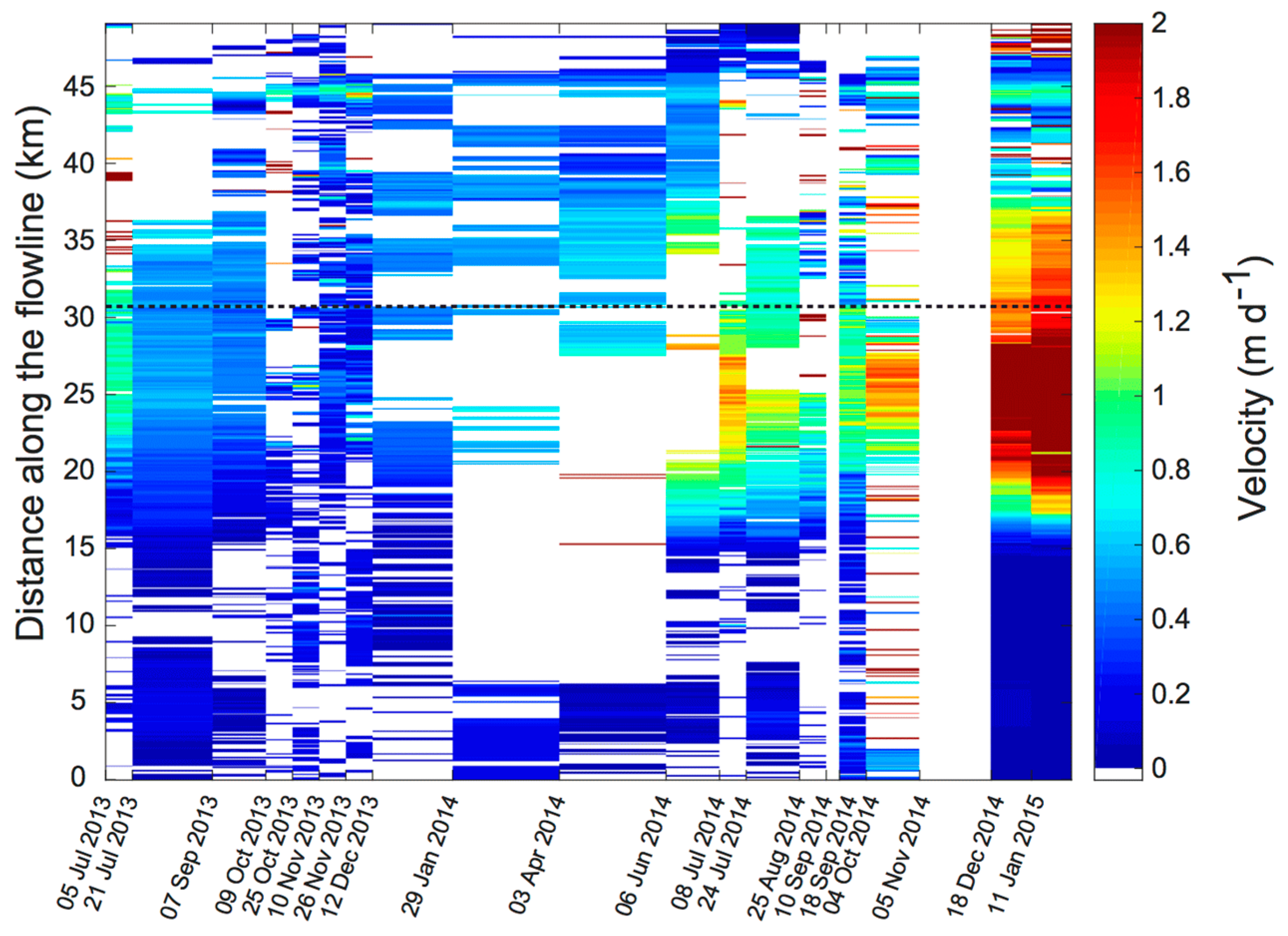

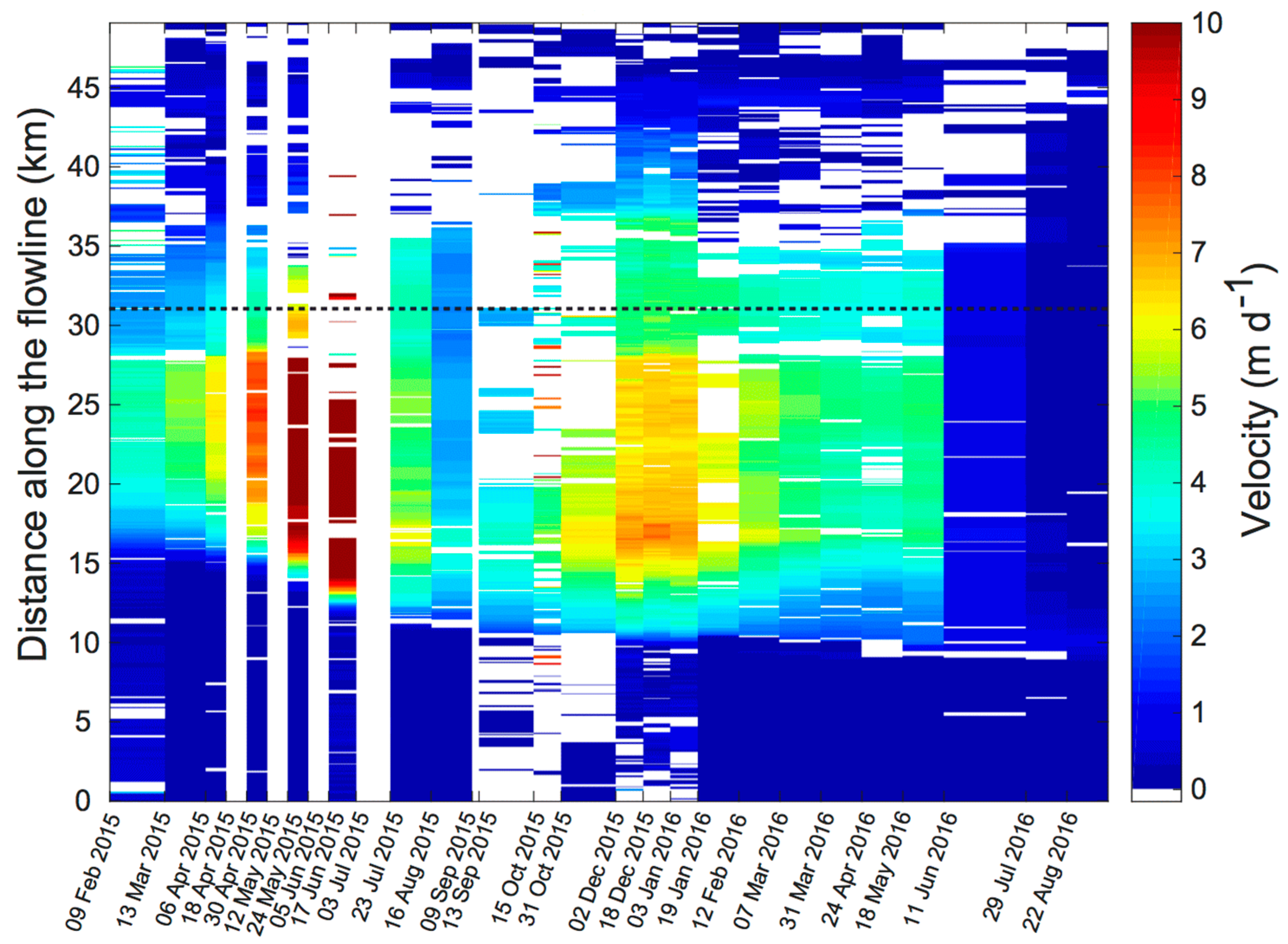
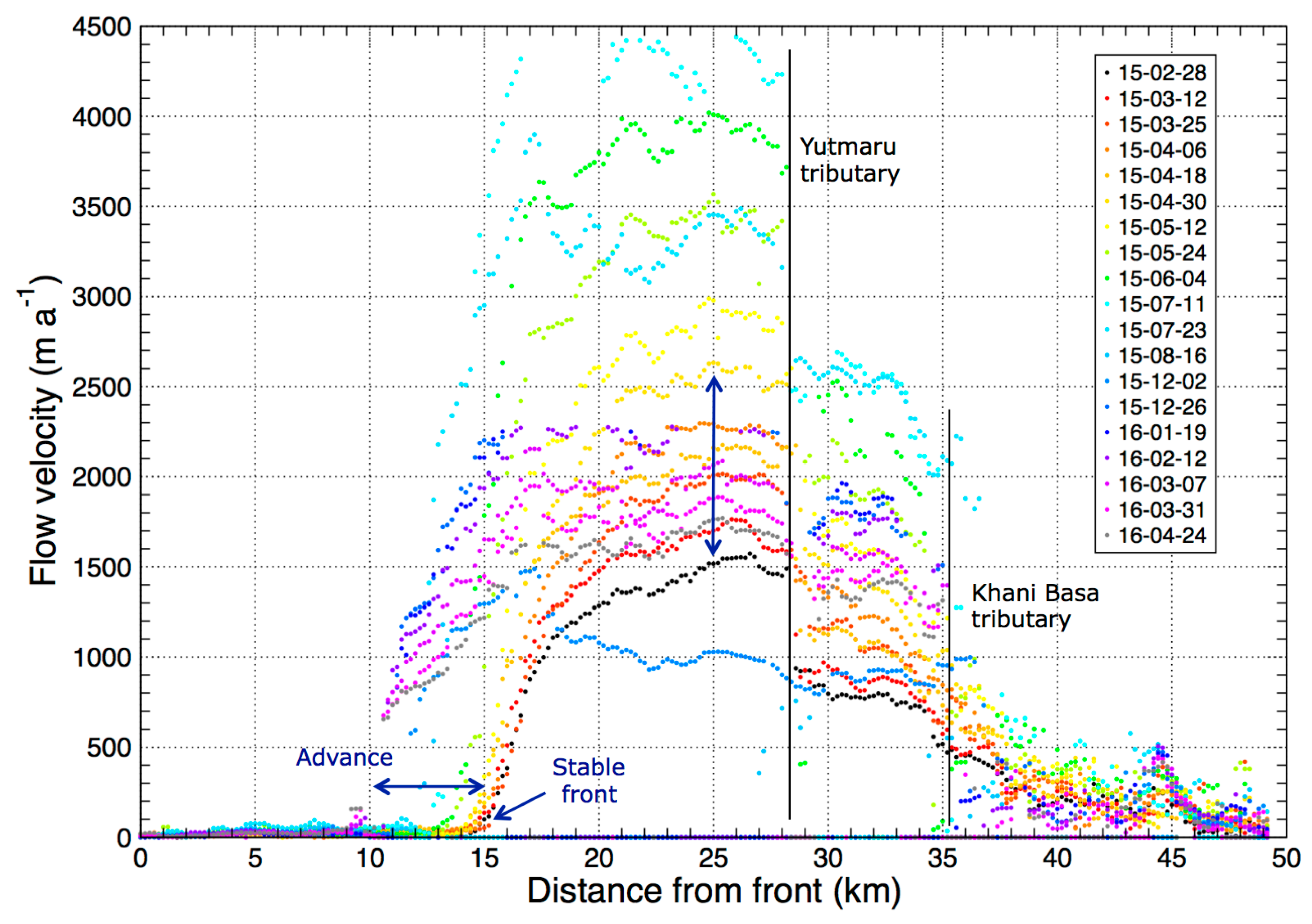
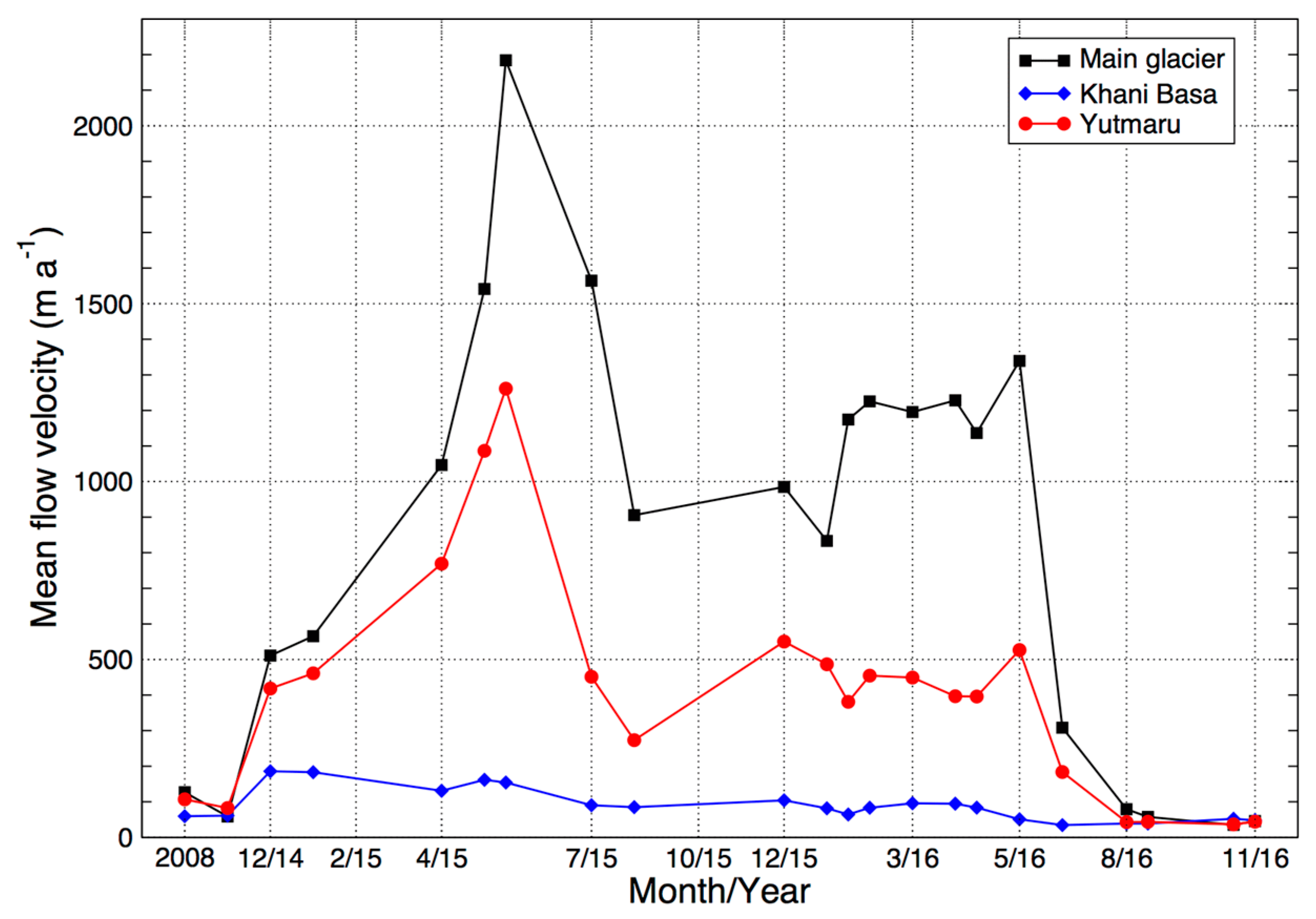
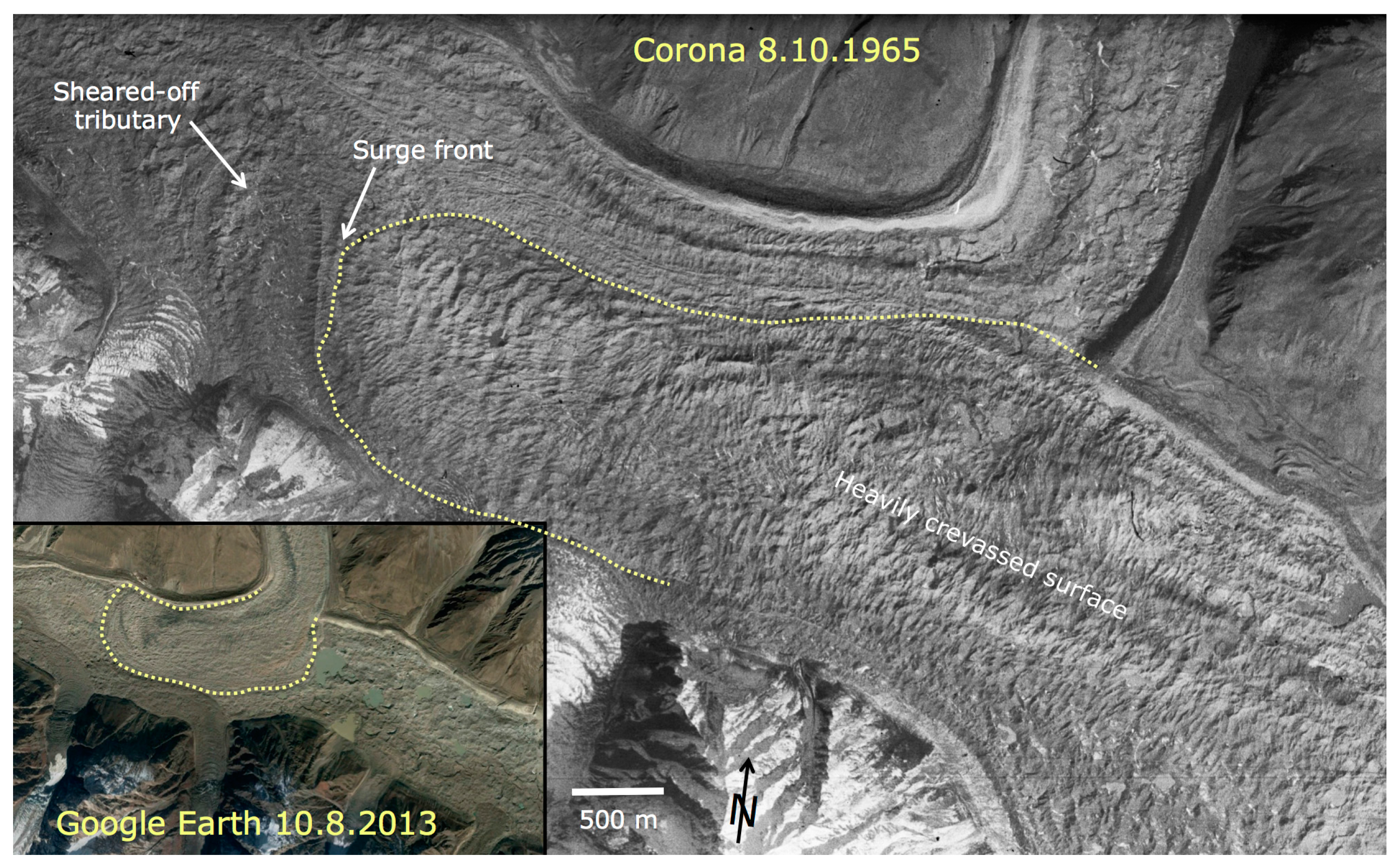
| Landsat ETM+ | Landsat OLI | RADARSAT-2 | Sentinel-1 | |
|---|---|---|---|---|
| Mode | Panchromatic | Panchromatic | Wide Fine | IWS |
| Scene coverage (km) | 170 × 183 | 170 × 183 | 150 × 150 | 250 |
| Pixel resolution (m) | 15 × 15 | 15 × 15 | 10.6 × 5.2 | 3 × 22 m |
| Matching window (pixel) | 15 × 15 | 15 × 15 | 38 × 77 | 256 × 128 |
| Search area (pixel) | 50 × 50 | 50 × 50 | 38 × 77 | 256 × 128 |
| Step size | 100 m | 100 m | 9 × 19 pixel | 40 × 10 |
© 2017 by the authors. Licensee MDPI, Basel, Switzerland. This article is an open access article distributed under the terms and conditions of the Creative Commons Attribution (CC BY) license (http://creativecommons.org/licenses/by/4.0/).
Share and Cite
Paul, F.; Strozzi, T.; Schellenberger, T.; Kääb, A. The 2015 Surge of Hispar Glacier in the Karakoram. Remote Sens. 2017, 9, 888. https://doi.org/10.3390/rs9090888
Paul F, Strozzi T, Schellenberger T, Kääb A. The 2015 Surge of Hispar Glacier in the Karakoram. Remote Sensing. 2017; 9(9):888. https://doi.org/10.3390/rs9090888
Chicago/Turabian StylePaul, Frank, Tazio Strozzi, Thomas Schellenberger, and Andreas Kääb. 2017. "The 2015 Surge of Hispar Glacier in the Karakoram" Remote Sensing 9, no. 9: 888. https://doi.org/10.3390/rs9090888





